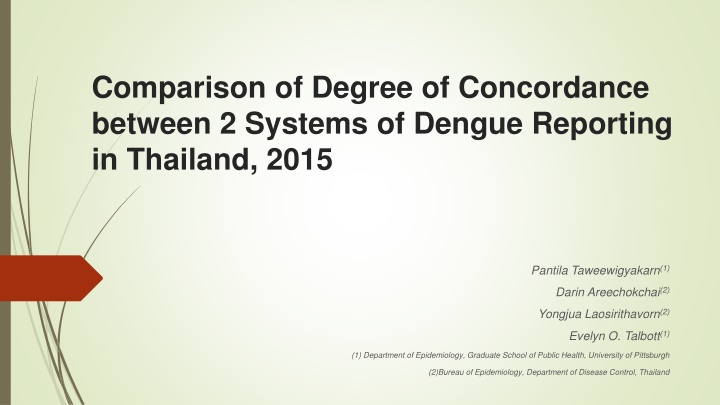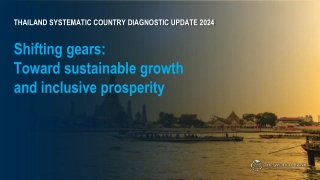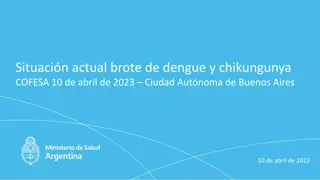Degree of Concordance between 2 Systems of Dengue Reporting in Thailand
This study examines the level of agreement between two dengue reporting systems in Thailand in 2015, authored by Pantila Taweewigyakarn, Darin Areechokchai, Yongjua Laosirithavorn, and Evelyn O. The research explores the consistency and accuracy of the systems' data, shedding light on the effectiveness of dengue surveillance strategies.
Download Presentation

Please find below an Image/Link to download the presentation.
The content on the website is provided AS IS for your information and personal use only. It may not be sold, licensed, or shared on other websites without obtaining consent from the author.If you encounter any issues during the download, it is possible that the publisher has removed the file from their server.
You are allowed to download the files provided on this website for personal or commercial use, subject to the condition that they are used lawfully. All files are the property of their respective owners.
The content on the website is provided AS IS for your information and personal use only. It may not be sold, licensed, or shared on other websites without obtaining consent from the author.
E N D
Presentation Transcript
Comparison of Degree of Concordance between 2 Systems of Dengue Reporting in Thailand, 2015 Pantila Taweewigyakarn(1) Darin Areechokchai(2) Yongjua Laosirithavorn(2) Evelyn O. Talbott(1) (1) Department of Epidemiology, Graduate School of Public Health, University of Pittsburgh (2)Bureau of Epidemiology, Department of Disease Control, Thailand
Introduction: Dengue Dengue : An infection caused by Dengue Virus Mode of transmission : Vector-borne (Aedes Aegypti mosquito) Symptoms : Wide range Asymptomatic Infection Mild Symptoms (Dengue Fever) : Fever, headache, nausea, vomiting Moderate Severe symptoms (Dengue Hemorrhagic Fever, Dengue Shock Syndrome) : Abnormal bleeding, Plasma Leakage Symptoms, Shock, Hepatitis, Renal Failure Death Burden of the disease : Worldwide: 3.2 million cases reported in 2015(1) f (approx 43.83 / 100,000 pop) Thailand : 144,952 cases reported ( 222.58 / 100,000 population) (1) WHO. Dengue and Severe Dengue. http://www.who.int/mediacentre/factsheets/fs117/en/.
Study Question Bhatt, 2013. estimated burden of Dengue in 2010 Worldwide: 96 million people should have clinical symptoms while WHO showed only 2.2 million cases reported Thailand : 1.37 million people with clinical symptoms , while the surveillance system captured 116,947 reported cases To capture all of symptomatic dengue cases is impossible. At least the surveillance should detect the cases visiting hospitals And reflect the correct distribution in terms of Time, Place, Person in order to indicate an appropriate response Thus, Is the surveillance system data concordant with the real situation? Bhatt S. et al. The global distribution and burden of dengue. Nature. 2013 Apr 25;496(7446):504-7
Communicable Disease Surveillance system in Thailand (R506) Electronic Based A data collection process is done manually by hospital epidemiologists. The process might vary in each hospital. Regional office of Disease Prevention and Control Government Hospitals 1 mo Bureau of Epidemiology (National level) 1-2 wk District Health office Provincial Health office 1-2 wk 1 mo Private Hospitals
The Electronic National Health Record (ENHR) The system collects every single visit of patients and automaticallysends the data to the database at provincial health office Health Data Center Bureau of Policies and Strategies, Ministry of Public Health Government hospitals Auto Sync The data collected in 43 different folders, depend on types of variables e.g. demographic data, diagnosis, lab study, medications, etc. Private hospitals Data Center at Provincial Health office Auto Sync 1 mo Primary Care Unit (Subdistrict Level) Auto Sync
Difference between R506 and ENHR Aspects R506 ENHR Objective/ Utilization - - Surveillance data Routinely used for surveillance purpose - Health information of all Thai population; from Birth to Death Not routinely used Used for research, annual summary for some certain diseases e.g. chronic disease, All diseases or purposes of hospital visit Most of information of patients e.g. demographic data, diagnosis code, laboratory results, prescription history admission information, cost of services The data is electronically sent from the hospitals to the provincial data center => closed to the real world data - - Data collection - Only notifiable communicable diseases Only variables that are relevant for disease prevention and control Hospital epidemiologists are supposed to collect the cases that meet the definition to be reported - - - - - Number of folder - A single folder contains relevant variables - 43 folders: PERSON, ADDRESS, DIAGNOSIS_OPD, CHRONIC, . Etc. Size of data - Small - Big data
Methods : Data Preparation Electronic National Health Records using MySQL 6 folders selected : DIAGNOSIS_OPD(outpatient), DIAGNOSIS_IPD(inpatient), DEATH, PERSON, ADDRESS, HOME Selected Dengue cases from DIAGNOSIS_OPD : variable diagnosis code contains A90 or A91 (ICD-10) DIAGNOSIS_IPD : variable diagnosis code contains A90 or A91 (ICD-10) DEATH: 6 variables of disease/condition contribute to death contains A90 or A91(ICD-10) Join the cases from 3 folder together (Union command) Removal duplication of records using ID Keep the record of the day of last diagnosis, regardless of patients type (OPD/IPD) If the day of diagnosis is the same but the diagnosis is different between OPD/IPD, keep IPD diagnosis Join the non-duplicated dataset to the folder PERSON, ADDRESS, HOME (Left join Command) Selected variables : ID, Sex, Birthdate, Diagnosis code, Date of Diagnosis, Death status (Yes/No), province
Methods : Data Preparation Data from Communicable disease surveillance system (R506) Single folder De-identified data Selected variables : ID, Sex, Age in year, Disease code, Date of Visit, Death status (Yes/No), province
Methods: Data Analysis Time Period : Jan 1 Dec 31, 2015 Inclusion criteria All records were included Exclusion Criteria When analyze each variables, the missing record would be excluded We study the distribution of the cases in term of sex, age group, race, months of diagnosis, address (province level).
Results Figure1. Number of Patients Diagnosed with Dengue recorded in the ENHR and the R506 surveillance databases by Area 70000 61858 60000 57661 50000 46676 40000 36304 30000 26271 23942 21766 18827 20000 11743 10000 679 0 NorthEast Central North South BKK R506 ENHR
Figure2 Number of Patients diagnosed Dengue by Disease severity Results Bangkok Included Bangkok Excluded 160000 160000 140000 140000 120000 120000 100000 100000 80000 80000 60000 60000 40000 40000 20000 20000 0 0 DF DHF DSS DF DHF DSS R506 ENHR R506 ENHR Figure3. Number of Patients diagnosed Dengue by Sex Bangkok included Bangkok Excluded 120000 120000 100000 100000 80000 80000 60000 60000 40000 40000 20000 20000 0 0 Male Female Male Female R506 ENHR R506 ENHR
Results Figure4 Number of Patients diagnosed Dengue Syndrome by Age Group Bangkok Excluded 90000 80000 70000 60000 50000 40000 30000 20000 10000 0 0-1 yr 1 - 9 10-19 20-29 30-39 40-49 50-59 60-69 70-79 80-89 90-99 R506 ENHR Bangkok included 90000 80000 70000 60000 50000 40000 30000 20000 10000 0 0-1 yr 1 - 9 10-19 20-29 30-39 40-49 50-59 60-69 70-79 80-89 90-99 Age Group R506 ENHR
Results Figure7. Number of Patients diagnosed Dengue by Month of diagnosis Bangkok included 35000 30000 25000 20000 15000 10000 5000 0 JAN FEB MAR APR MAY JUN JUL AUG SEP OCT NOV DEC R506 ENHR Bangkok excluded 35000 30000 25000 20000 15000 10000 5000 0 JAN FEB MAR APR MAY JUN JUL AUG SEP OCT NOV DEC R506 ENHR
Figure8. Number of dengue cases by month and region (Bangkok excluded) Results Central NorthEast 10000 10000 8000 8000 6000 6000 4000 4000 2000 2000 0 0 JAN FEB MAR APR MAY JUN JUL AUG SEP OCTNOVDEC JAN FEB MAR APR MAY JUN JUL AUG SEP OCT NOV DEC R506 ENHR R506 ENHR North South 10000 10000 8000 8000 6000 6000 4000 4000 2000 2000 0 0 JAN FEB MAR APR MAY JUN JUL AUG SEP OCT NOV DEC JAN FEB MAR APR MAY JUN JUL AUG SEP OCTNOVDEC R506 ENHR R506 ENHR
Discussion Similar distribution between data from the surveillance system and ENHR sex, age group, race, disease severity, and type of treatment Different distribution Geographical data : missing data in ADDRESS and HOME folder in ENHR Time of diagnosis : missing data in ENHR (an effect of fiscal year activities) The Surveillance system (R506) captured approximately 30% less than the cases recorded in ENHR Human-dependent process in the surveillance system The patients in NEHR might have the diagnosis changed later (The information in NEHR might be overestimated) Surveillance system detected more dead cases than ENHR Physicians incorrectly reported a cause of death Huge missing data problem found in ENHR in ADDRESS, HOME folders Less problem seen in other folder such as DIAGNOSIS, PERSON and DEATH
Conclusion The data from R506 represent the similar pattern of distribution of dengue to the data from ENHR in terms of sex, age, race, age groups at national level The distribution of dengue cases in terms of time of diagnosis and places were not be able to be compared due to poor data quality of the ENHR. ENHR requires improvement of data quality so that the system is able to an effective data source for health study and research. Acknowledgement We would like to express our appreciation to the center of epidemiological informatics (CEI), Bureau of Epidemiology, Ministry of Public Health, Thailand for a great cooperation.
References World Health Orgainization(2016). Dengue and Sever Dengue. Retrieved from http://www.who.int/mediacentre/factsheets/fs117/en/ Rojanapithayakorn W.(1998). Dengue Hemorrhagic Fever in Thailand. Dengue Bulletin. 22.60-72 Hammon, WM. (1973). Dengue Hemorrhagic Fever Do we know its cause?. The American Journal of Tropical Medicine and Hygiene. 22(1).83-91 Bhatt S. (2013). The global distribution and burden of dengue.Nature.496(7446):504-7 Limpakanjanarat K.,Thiraratkul A.,Ungchusak K.(n.d.) Three decades of DHF Surveillance in Thailand, 1958-1987. Retrieved from http://apps.who.int/iris/bitstream/10665/146020/1/dn1991v16p11.pdf Bureau of Epidemiology.(n.d.). Concept of Surveillance system adjustment. Retreived from http://www.boe.moph.go.th/files/meeting/506.pdf























